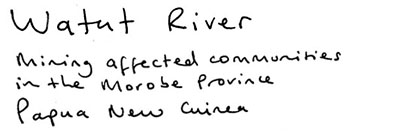THE HIDDEN VALLEY ENVIRONMENTAL IMPACT STATEMENT
An Environmental Impact Statement (EIS) was released for public comment in February 2004 (Enesar, 2004), and formed the basis upon which Abelle/Harmony sought approval to develop the Hidden Valley project. This section only briefly touches upon the issues and commitments around the project proposal, tailings, waste rock, water, acid mine drainage, baseline studies, environmental monitoring and management generally.
Project Proposal: Stage 1 was to last 6.5 years and process 3.5 Mt of ore per year and produce about 8,900 kg of gold and 124,000 kg of silver per year (or ~275,000 ounces gold, ~4,000,000 ounces silver). All three deposits would be mined, including the Hidden Valley, Kaveroi and Hamata deposits. The mill would be built adjacent to the Hamata pit. In total, 21.5 Mt of ore would be processed and about 107 million cubic metres (Mm3) of waste rock would also be mined, or some 300 Mt. The identified mineral resource reported was, in contrast, 36.2 Mt ore at 3.2 g/t gold (containing ~113,500 kg or 3.65 million ounces of gold). Stage 2 development, which would mine and process ore beyond 6.5 years, would require further assessment via a new EIS.
Tailings Management: a tailings storage facility (TSF) would be constructed adjacent to the Hamata pit, taking advantage of a relatively flat area in a small valley. The tailings would be deposited using sub-aerial methods, where the slurry from the processing plant would be discharged via beaches, allowing the tailings to settle and consolidate into a solid mass. Given the high rainfall of about 2.6 to 2.8 metres per year and pan evaporation rates of between 1 to 1.2 metres per year, the site has a strongly positive water balance and therefore accumulates water in dams such as the TSF. Tailings water will be treated to reduce cyanide and heavy metal concentrations and excess water from the TSF is to be discharged via Pihema Creek to the Upper Watut River.
Waste Rock: all Hidden Valley/Kaveroi waste rock to be placed in dumps as close as practicable to the pits, generally aiming to fill valleys after accounting for potential acid formation risks (ie. acid mine drainage), dump stability and drainage of water from the dump. Hamata waste rock is to be used in the tailings dam walls.
Acid Mine Drainage: waste rock will be assessed for its potential to form acidic drainage, and managed accordingly. Any formation of acidic waters in the pit will be monitored and addressed either through water treatment (eg. neutralisation) and discharge to adjacent streams or through sending this water to the process plant.
Water: due to the strongly positive water balance (ie. higher rainfall than evaporation rates), the vast majority of water required will be captured on site and managed according to quality and needs. Fresh water for potable (drinking) purposes will be extracted from the Upper Watut River at a long-term average rate of 110 cubic metres per hour (m3/hour).
Baseline Studies: in general, no new baseline studies were conducted, with the previous CRA studies and some additional studies by Abelle/Harmony used to characterise the existing environment, such as flora, fauna, climate, land and resource use, and water quality, amongst other aspects. Air quality and noise were not assessed. Water quality was generally good, though some heavy metals in some samples exceeded PNG guidelines for either environmental or drinking water purposes. Sediment loads in the Bulolo River due to small scale mining were about 0.15 million tonnes per year (Mt/yr), while the Wau gold mine discharged about 0.7 Mt/yr from 1984 to 1990. The Middle Watut River, downstream of the Upper Watut and Bulolo confluence, was estimated to carry sediment loads of 4.7 Mt/yr.
Environmental Monitoring and Management: a detailed environmental management plan (or EMP) was developed, which included further baseline studies and validation monitoring as well as plans for operational and post-closure monitoring. In general, monitoring was to include water quality, climate, sewage treatment performance, biodiversity and other aspects. An environmental management plan (EMP) was prepared and released in November 2005 (see Enesar, 2005).

